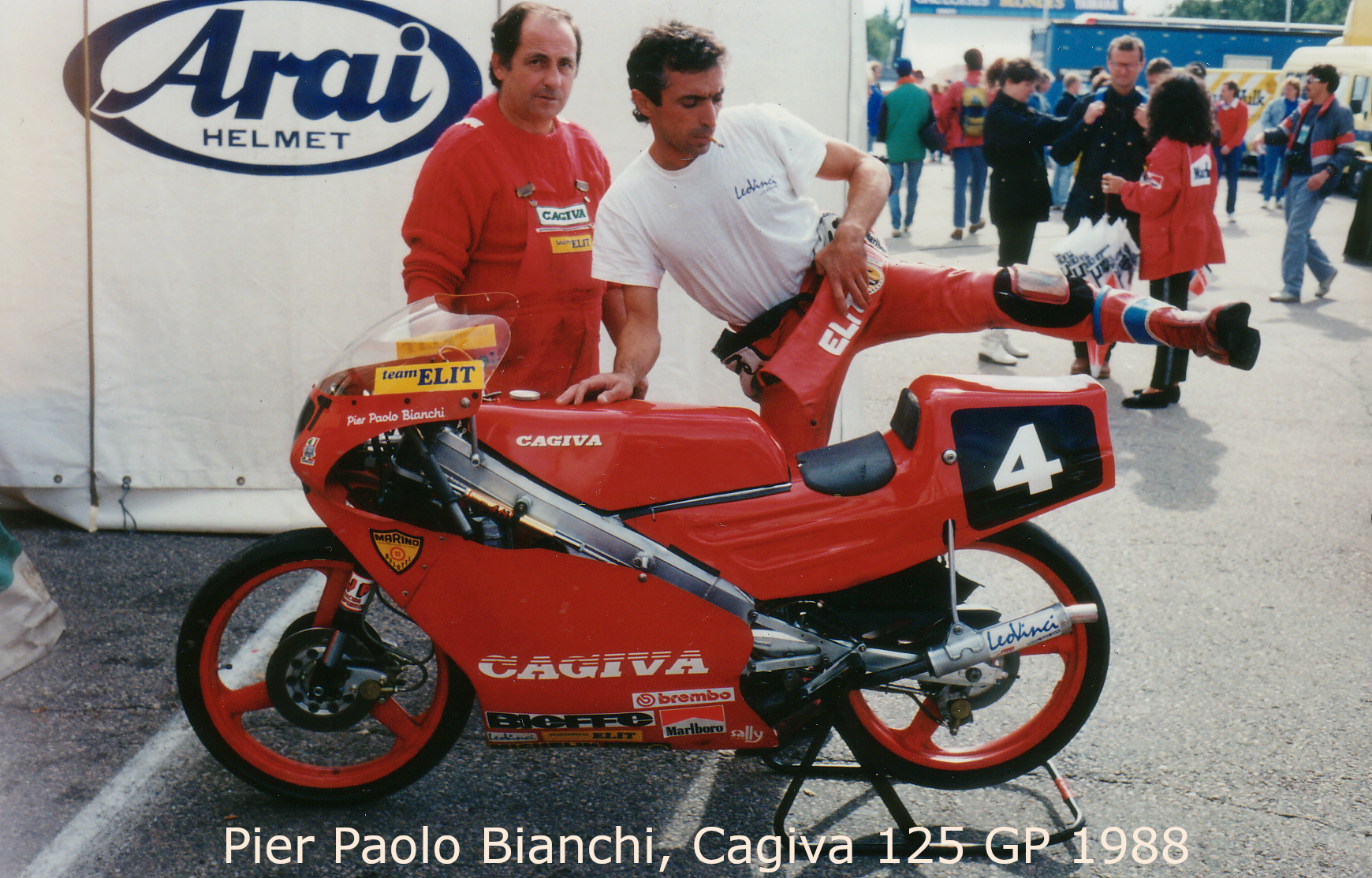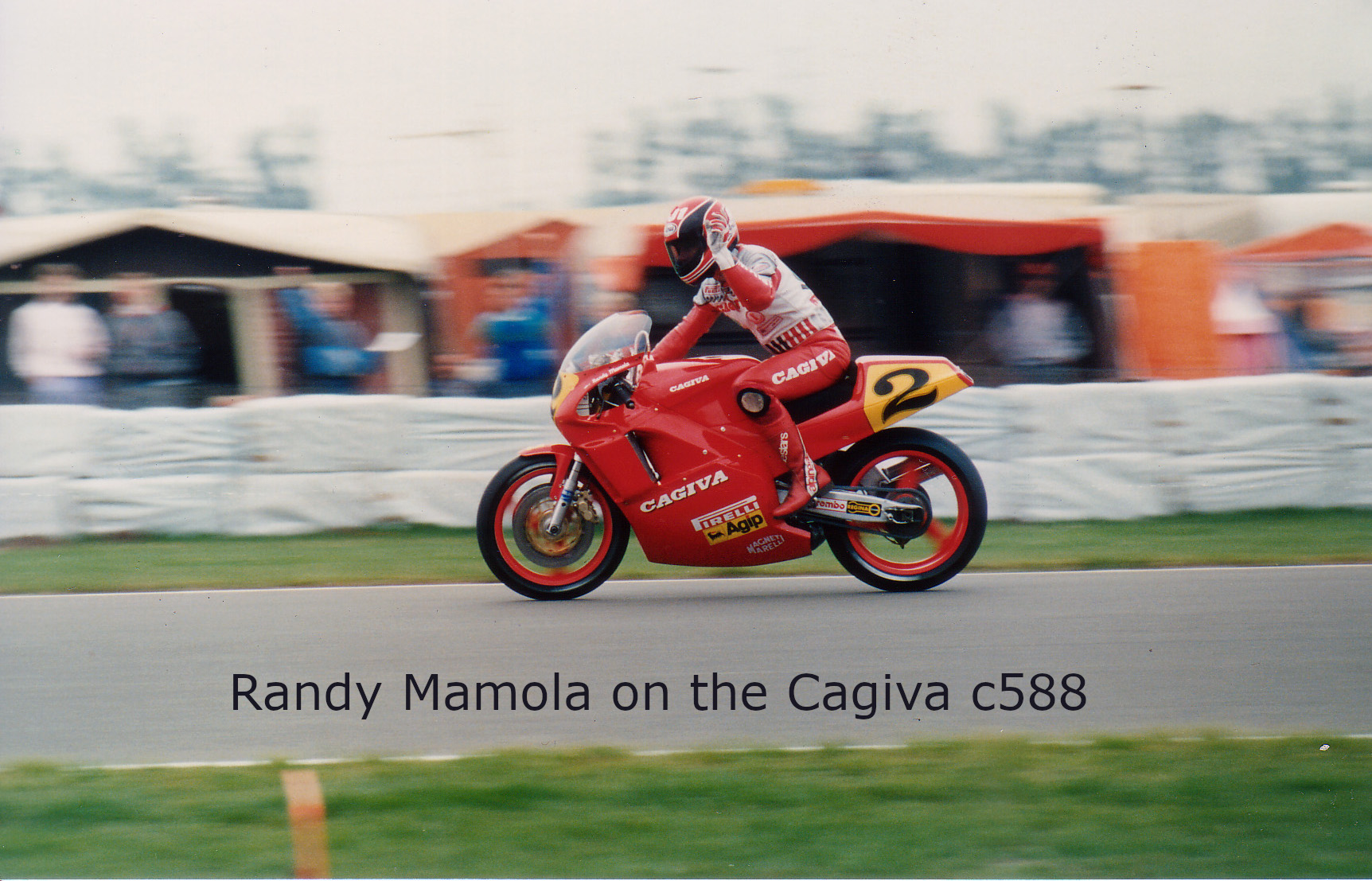Cagiva and the Castiglioni brothers story
A story about the brothers who saved Ducati, about their dream and a motorcycle factory by the Lake of Varese.
By Micke Werkelin. Written between the late 90's and 2022. Sourses are from all kinds of motorcycle magazines, newspapers, books and inernet pages. Feel free to contact me for corrections
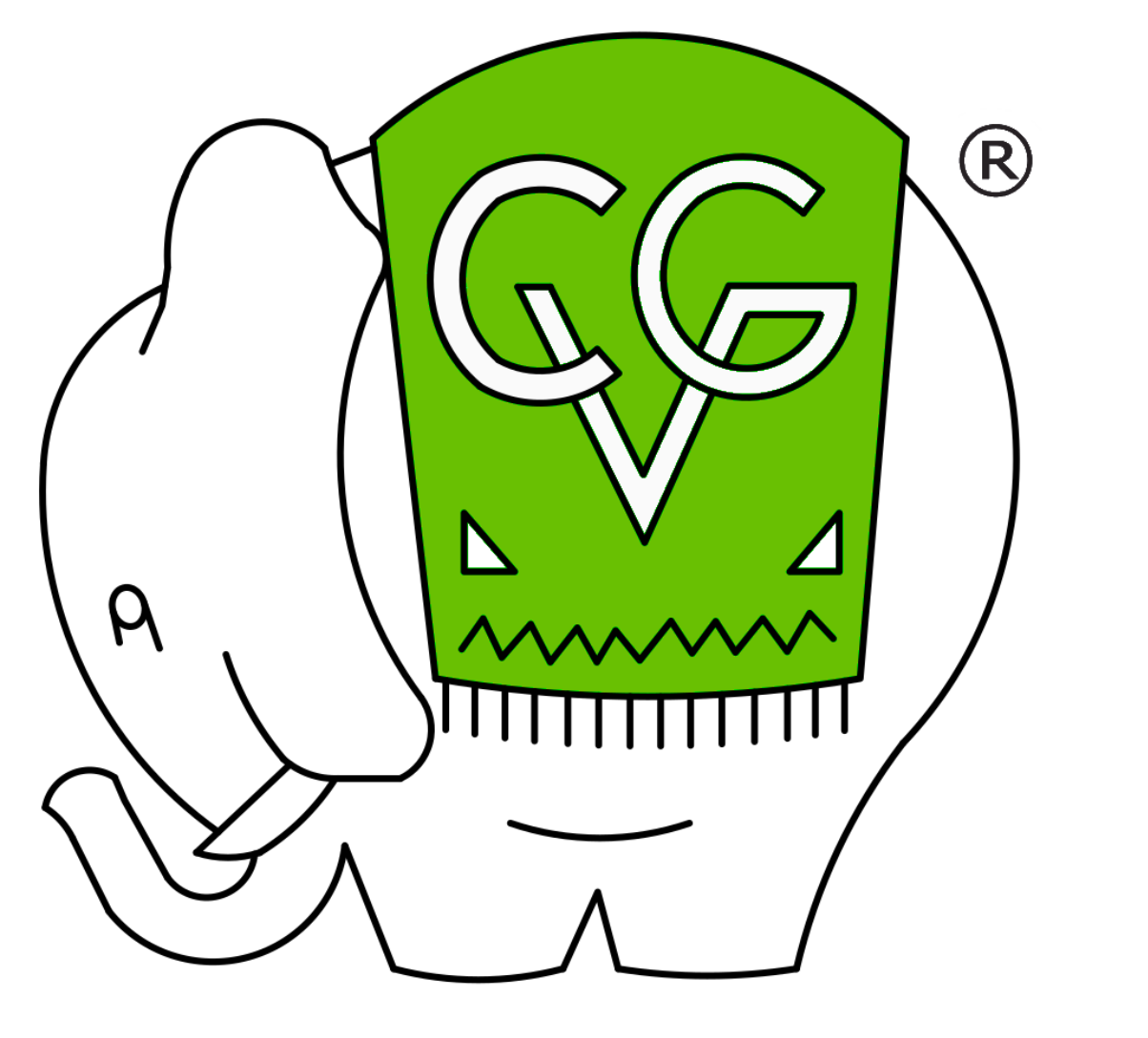
June 1983: total confusion
Ducati called for a press conference held on Thursday, June 2, 1983. Cagiva and Ducati had reached an agreement on a seven-year collaboration. Ducati would supply Cagiva with engines from 350 cc to 1000 cc. So far, everyone understood. Then there were divided opinions about what the agreement meant. Cagiva claimed that they also took over the marketing and sales of Ducati's motorcycles. Ducati considered that they could continue to sell their motorcycles as usual. Then there were the owners of Ducati, VM Group (the Italian state and the Vatican), who believed that Ducati would stop manufacturing complete motorcycles to concentrate on engines for motorcycles (Cagiva), boat engines (their own brand and under the name VM) and car engines for Alfa Romeo, Rover and later Lancia (Ferrari V8). The questions among journalists, dealears and ducatistis were: Who are Cagiva? Is this the end for Ducati? Who wants to buy a Ducati with a completely unknown name?
1984: Engagement
The questions were justified. Two years of confusion followed. Ducati's production decreased every year. In 1984 they had the following models, 900S2, 900 MHR and 650 Pantah. The model range was ancient. The Pantah engine was fine, but it needed a more modern chassis. In Italy, Ducati was not marketed at all! Many believed that Ducati's days were numbered. Then came the Cologne Motorcycle Fair in 1984. 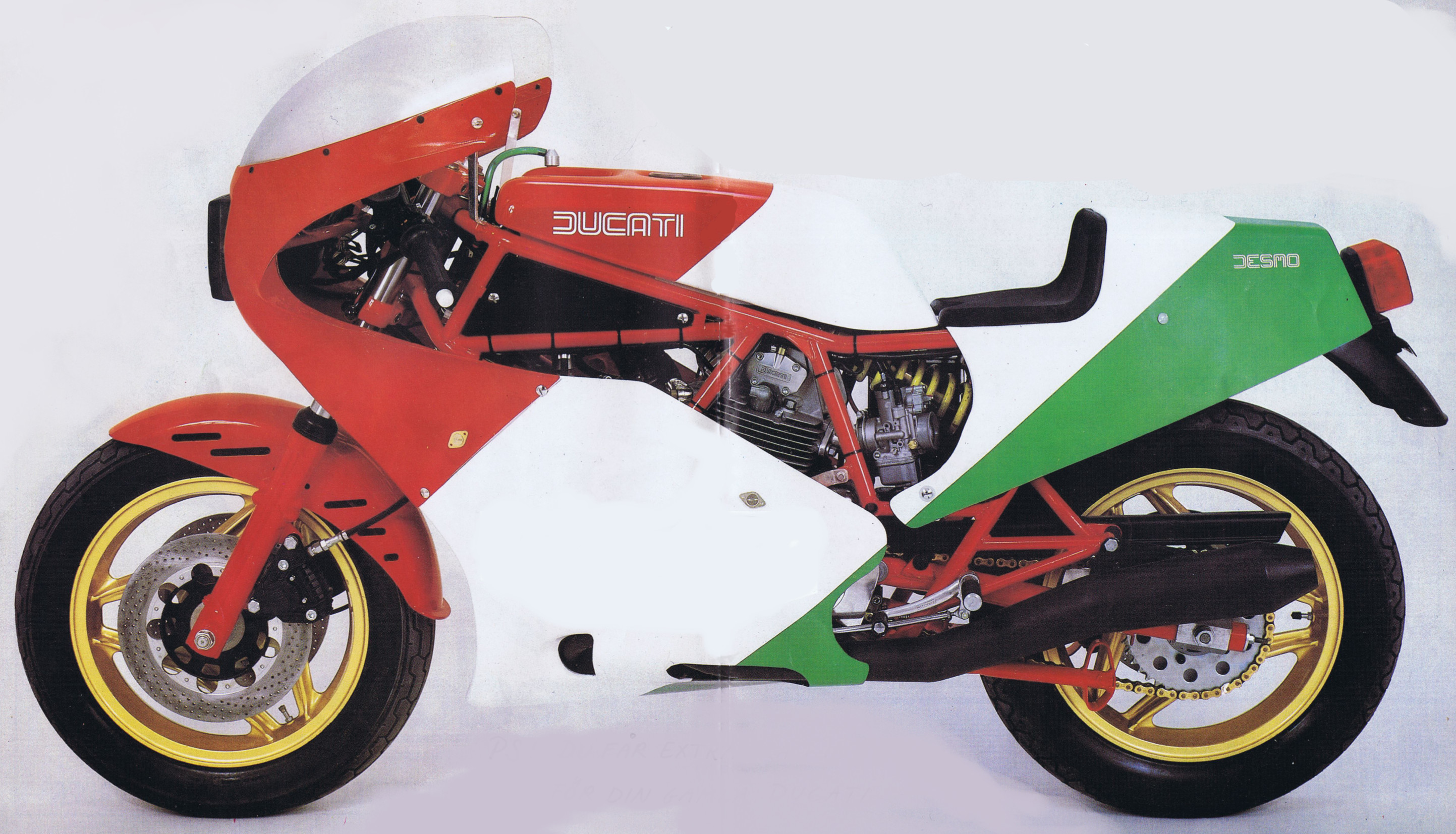 Ducati gave out a brochure with a new motorcycle: the Ducati 750 Pantah F1. They had taken their TT1 racer and equipped it with lights and turn signals. The response was huge. Das Motorrad's readers voted it as the motorcycle of the year! There was only one problem: it did not exist! The brochure was a coup from Ducati Meccanica without the owners' (VM-group) knowledge. Cagiva was also not happy about the new competitor. During the autumn, Cagiva had started manufacturing the Cagiva 650 Alazzurra. It was a Pantah TL with a new design. The whole bike was a pick and mix from subcontractors. The frame was bought, like the Ducati, from Verlicchi and the engine was the same 650 as in the 650 Pantah.
Ducati gave out a brochure with a new motorcycle: the Ducati 750 Pantah F1. They had taken their TT1 racer and equipped it with lights and turn signals. The response was huge. Das Motorrad's readers voted it as the motorcycle of the year! There was only one problem: it did not exist! The brochure was a coup from Ducati Meccanica without the owners' (VM-group) knowledge. Cagiva was also not happy about the new competitor. During the autumn, Cagiva had started manufacturing the Cagiva 650 Alazzurra. It was a Pantah TL with a new design. The whole bike was a pick and mix from subcontractors. The frame was bought, like the Ducati, from Verlicchi and the engine was the same 650 as in the 650 Pantah.
Fabio
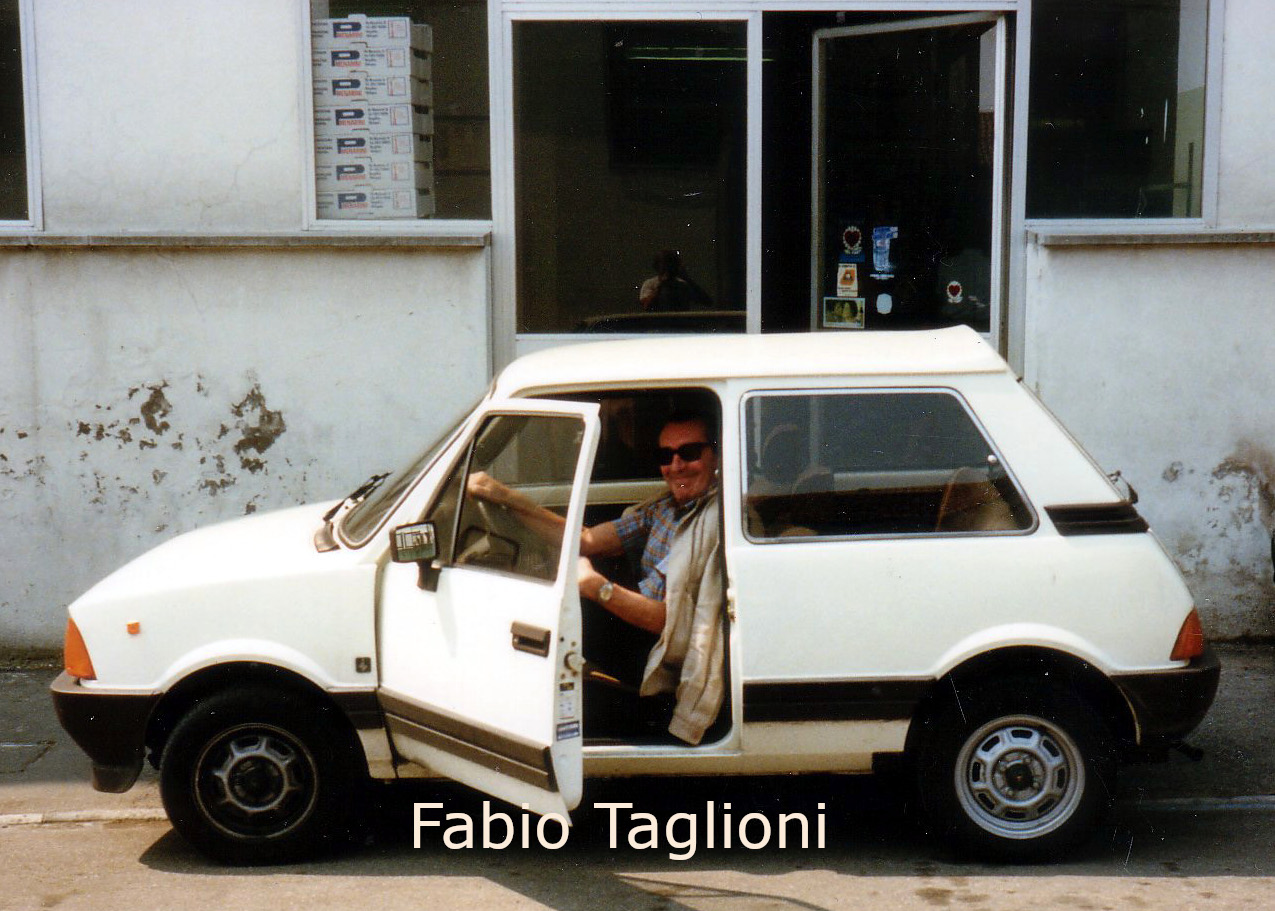
Fabio Taglioni, the famous designer who had joined Ducati in the mid 50's, had retired in 1982. He was disappointed with Ducati, who opposed him, especially in recent years. His last design that saw the light of day was Pantah, after the factory completely failed with the 180 degree parallell twins that Taglioni did not design. However, Fabio wanted to go further. A single cylinder 350 version of the Pantah that was shown at the Milan Motor Show in 1977 (Utah & Rollah) had been dismissed by the factory management. Fabio successfully continued to design a ninety degree V4 of 1000 cc. The first version was developed in 1976. Note that this was many years before Honda presented a similar concept. The second version was completed in 1981 and gave a full 131 horsepower in the dyno test at 12,000 rpm! The factory management also shut down this project and Fabio withdrew. In 1983, Taglioni worked as a consultant for Cagiva to develop a new variant of the 650/750 engine with the back cylinder head reversed. This was a required by Cagiva to be able to use the engine in a new on / off-road machine. The machine saw the light of day at the Milan Motor Show in 1983 and was called the Elefant. Cagiva also quickly needed new road machines with the Pantah engine and the bevel engine (which would soon be 1000 cc). They did not have their own designers with experience of modern large road motorcycles. Therefore, the first assignment went to Bimota and the designer Federico Martini. He was commissioned to develop a two-seater sports bike with the 650 Pantah engine. In 1984, Cagiva hired Massimo Tamburini, who after leaving Bimota worked with race bikes for Roberto Gallina. Tamburini was commissioned to develop a modern chassis for the large bevel engine. At the same time, they let an American design company do a study of a custom bike with the big bevel engine. The funny thing is that none of these motorcycles came into production! At least not in this form.
1985: Marriage
Ducati starts producing the F1. The design had changed a lot compared to the prototype. But, it was incredibly raw in its simplicity. They had taken the old TT1 frame, without links to the suspension, and reinforced the rear frame. The engine was an enlarged 650 with wet clutch. The brakes were standard P08 Brembo and the fork a standard Marzocchi. The fairing had become more angular and the 16 "rear wheel had been replaced with an 18" (the prototype had 16"). However, the front had a 16", just like on many other contemporary motorcycles. It may have been spartan, but the charisma and driving pleasure was good. On May 1, the message came that shocked the entire motorcycle world: Cagiva buys Ducati! The confusion became even bigger for a short time. At first it was clear that the name Ducati would disappear! Then a lot of new models and other changes were presented. Ducati had already come out with the last variant of the bevel: Mille. Mille was the optimal version. All weak points were now cured and the engine was more or ess bullet proof. But it was far too expensive to manufacture. Cagiva stopped production and the last ones were manufactured in the spring of 1986. They had Oscam wheels of the same type as F1 (however 18 "front). The F1 was presented to the press with both Cagiva and Ducati's names on the fairing! However, after major protests from retailers, especially in the United States, it was decided to keep the Ducati name. Already in the summer of 1985, the F1 had a dry clutch, white Veglia and floating brake rotors. Ducati manufactured a total of 7000 motorcycles in 1985. During the year, the Pantah and Alazzurra's successor from Bimota was ready. Massimo Tamburini was commissioned to evaluate the result. He thought the machine, with its trellis frame, was fine, but far too expensive to produce. Bimota was bankrupt during this time. As payment, Bimota was given the right to produce the frame itself and thus the right to buy engines from Ducati. It eventually resulted in the beautiful DB1. In my opinion, it is the most beautiful and uncompromising (read useless if you will) motorcycle made for street use. It is also claimed that Tamburini helped with the design. It eventually saved Bimota from becoming bankrupt. By skipping the Mille engine, Tamburini redesigned its prototype to fit the 750 engine. It eventually became Paso. The, in my opinion, most beautiful sports tourer who has seen the light of day. It was named after Renzo Pasolini who was both the brothers C's idol and a good friend of Massimo Tamburini. The American project resulted in Indiana. A strange custom bike with the Pantah engine that no one wanted. All this was presented at the Milan Motor Show the same year. The world shouted: What in he** is Cagiva?
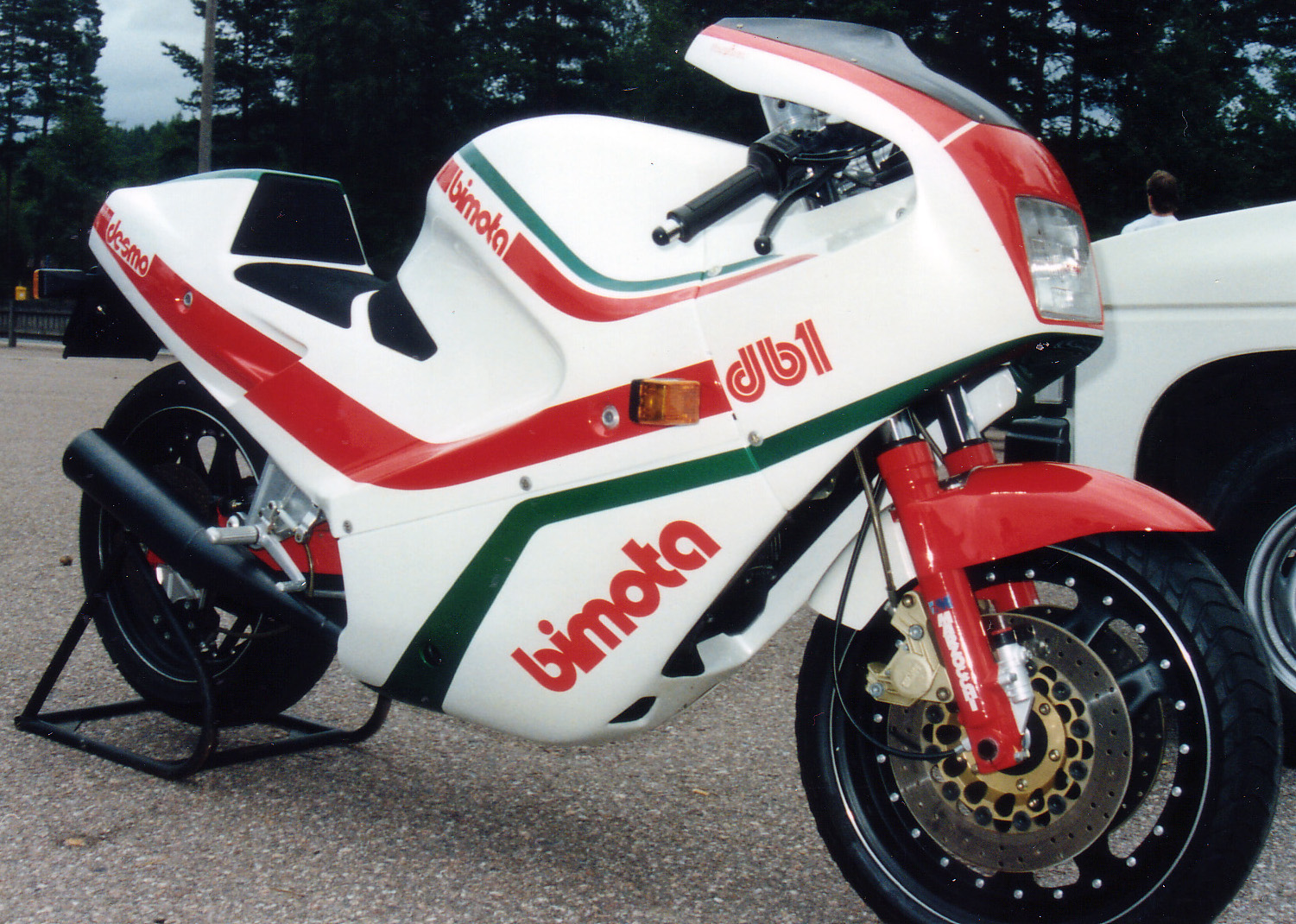
1978: Cagiva is formed
We turn back the clock to October 7, 1978. Then a company is formed in Varese called Cagiva. Cagiva is an abbreviation of CAstiglioni GIovanni VArese. Giovanni Castiglioni had started a company, Castiglioni Giovanni Varese S.p.a., which went brilliantly. The company manufactured small pressed sheet metal details, mainly buckles and locks for bags, bracelets and belts, in other words metal buckles for leather straps. Giovanni had earned a fortune on the company that had the famous elephant as a logo with the company's initials CGV. His sons inherited both the company and the fortune. The sons, Gianfranco and Claudio, were very interested in motorcycles and now invested part of their fortune in buying a motorcycle factory. The goal was to make the name Cagiva known throughout the world. They would almost succeed! Cagiva became a subsidiary of Castiglioni Giovanni Varese S.p.a.
1912-1955: Aeronautica Macchi
Now we turn the clock back to 1912. Then Giulio Macchi formed the company Aeronautica Macchi in Schiranna by Lake Varese. They made seaplanes and soon shortened the name to Aermacchi. During the First World War, the company grew. During the 30's, they won the glorious Schneider Trophy competition for aircraft by flying with MC 72 at 709 km/h, which was the highest speed ever in this competition. During the Second World War military aircraft were needed and that is something they still do today, but in a different place and with a different name. After the war, they started making a three-wheeled "truck" with a diesel engine! Lino Tonti, who previously worked for Benelli and who designed aircraft engines during the war, was also hired. His task was to design a light motorcycle. In 1950, the machine saw the light of day. It was a two-stroke 125 in an open frame with the engine built in unit with the rear suspension! Where the tank normally sat, a luggage compartment had been placed (25 years before the Honda Gold Wing). A sports model was also developed with a closed frame and a normal fuel tank. In 1953, a twin was presented where, in principle, two 125s were put together. In 1955, Tonti designed a small four-stroke engine of 50 cc (40 * 39 mm, 7 hp / 12000 rpm) and 75 cc (44.5 * 43 mm, 9 hp / 11000 rpm) with double chain-driven overhead camshafts! The engine was placed in a cigar-shaped creation that was wind tunnel tested in Aermacchi's own wind tunnel. The machine broke speed records for both 50 cc and 75 cc. The 50 cc reached a incredible speed of 82.4 km/h after one mile (1608 m) with a standing start. With 75 cc engine, it reached 161 km/h over a flying mile and 174.9 km/h over the flying kilometer. All this were a world records set on the highway between Varese and Milan on April 4, 1956 under miserable conditions. The driver was Massimo Pasolini, father of Renzo.
1956-1959 Aermacchi Chimera, the start of something big

After the success, Tonti left and his replacement became Alfredo Bianchi. He had previously worked for Alfa Romeo and Parilla. At Parilla, he had designed a successful 250 with an overhead camshaft. For a short period he produced his own two-stroke engines under the name Astoria of 125 and 175 cc. Bianchi's assignment at Aermacchi was to design a motorcycle whose design was already given. The design was made by Count Revelli who previously competed on a motorcycle but who was now a well-known car designer. The design was bold and encapsulated. The year was 1956 and it was a trend among motorcycle manufacturers to encapsulate the motorcycles. What was not found out was that customers did not want encapsulated motorcycles. So the trend was short-lived and did not return until Ducati Paso appeared in 1986. The Aermacchi Chimera, as the machine came to be called, had a 175 cc engine and, unlike many contemporary Italian motorcycles, had a push rod engine. To fit the design, the cylinder leaned straight ahead. The machine sold poorly and it did not help that it was enlarged to 250 cc in 1958. Now it had also been clear that customers wanted traditionally naked machines. Therefore, Ala Bianca (White Wing), Ala Azzurra (Blue Wing), Ala Verde (Green Wing) and Ala Rossa (Red Wing) were produced with 175 and 200 cc engines. Since the Aermacchi was an Italian brand, a competition model was developed that in the 175 cc version had 20 hp compared to the standard machine's 13 hp and the sports model's 15.5 hp. The competition machine made its debut in 1960 in the West German GP with Alberto Pagani as driver. It went so well that it was decided to manufacture the machine for private drivers. The machine was called Ala d'Oro (the Gold Wing) and had Chimeran's long-stroke 250 engine (62 * 72), four-speed gearbox and the engine produced 22 hp at 8000 rpm. The motorcycle could be bought complete with lights and soon became a popular racing machine in Italy.
1960-1963: Harley Davidson Aermacchi
However, motorcycle production had not gone so well for Aermacchi. They were looking for a partner. In 1960, help came from the west in the form of the old American manufacturer Harley Davidson. They simply bought 50% of Aermacchi's motorcycle factory in the old aircraft hangar by Lake Varese. Harley was mainly interested in a scrambler model Aermacchi developed and which was a great success with Lanfranco Angelini as driver. Harley needed it and other small machines for the American market. It was a boost for Aermacchi who was now named Aermacchi Harley Davidson. After a few years, 75% of the motorcycles were exported to the United States. Of course, Harley Davidson left their mark on Aermacchi. They modified 250 Ala Verda with high handlebars and a scrambler look called Wisconsin. It eventually changed its name to Sprint (GTS in Europe) and was manufactured as 250 and 350 until 1974 when it received both a double cradle frame and an electric start!
1964-1967: The limit is reached for the four-stroke
In 1964, the limit was reached on the race track for the long-stroke 250 and a short-stroke variant (72 * 61) was developed for racing with a five-speed gearbox and a dry clutch. It is said to have been the first mass-produced motorcycle with a five-speed gearbox. The power was 28 hp and was increased in 1965 to 30. It was an impressive power for a small push rod engine. In 1963 came a 350 version of the Ala d'Oro with 33 hp. However, Bianchi realized that the push rod engine had its limitations and developed a variant for racing with double overhead camshafts. Two bikes were built before HD stopped the project when they decided that the racing motorcycles would be similar to the road motorcycles. Aermacchi bikes also became increasingly reliable, making it even more popular with private riders. It was sold in larger numbers than what e.g. Norton Manx ever done. International success was soon achieved. In 1966, Renzo Pasolini came 3rd in the World Champions table after an even
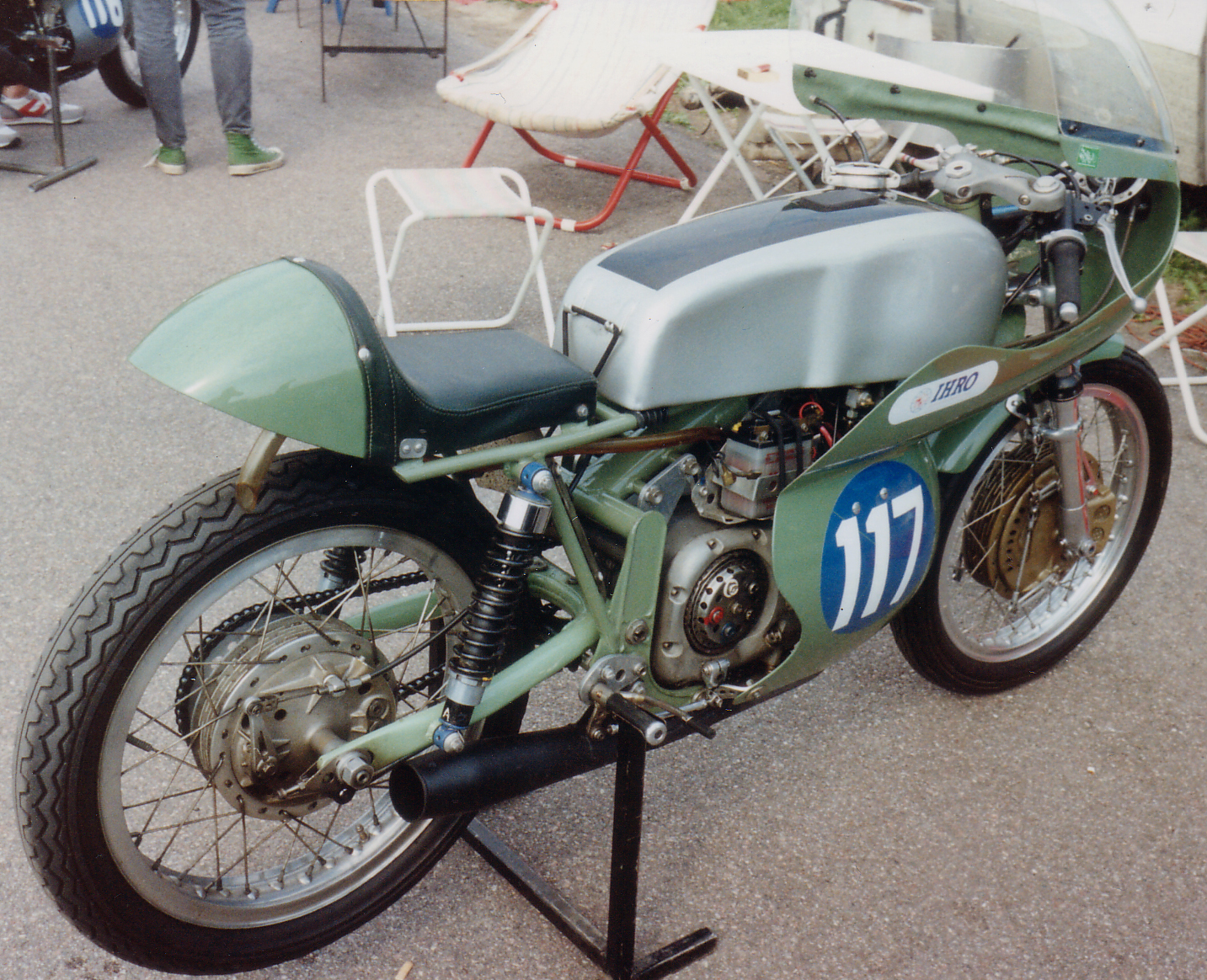 season where he and teammate Alberto Pagani entered as 2nd and 3rd in the Italian GP. Until next year, the power of the 350 was increased from 38 to a full 42 hp and Kelvin Caruthers turned Paso's achievement into 3rd in the 350 class. In 1967, a small two-stroke 125, Rapido, with the dimensions 56 * 50 was presented. That engine would survive the entire 70's, eventually under a completely new name. It would also be of great importance for the upcoming competition activities.
season where he and teammate Alberto Pagani entered as 2nd and 3rd in the Italian GP. Until next year, the power of the 350 was increased from 38 to a full 42 hp and Kelvin Caruthers turned Paso's achievement into 3rd in the 350 class. In 1967, a small two-stroke 125, Rapido, with the dimensions 56 * 50 was presented. That engine would survive the entire 70's, eventually under a completely new name. It would also be of great importance for the upcoming competition activities.
1968-1977 Paso and Villa
At the same time, Lino Tonti reappeared at Aermacchi with a small side project. He literally put two four-stroke 250s together and got a very fast and very unreliable 500. The machine was called Linto and placed itself 2nd in the Dutch GP in 1968. Only about ten Linto’s were built and they have a high collector's value today. Soon, however, a push rod engine wasn’t enough as the two strokes had become too fast. In 1972, Paso came 2nd in the 250 class and 3rd in the 350 class with two-cylinder two-stroke designed by Ezio Mascheroni. The machine, like the Linto, was designed by basically combining two single-cylinder engines. In this case 125's. The motorcycles were now only called Harley Davidson after AMF-Harley Davidson bought the remaining fifty percent of Aermacchi. 1973 would be the big breakthrough for Paso, but fate wanted otherwise and he and Jarno Saarinen were 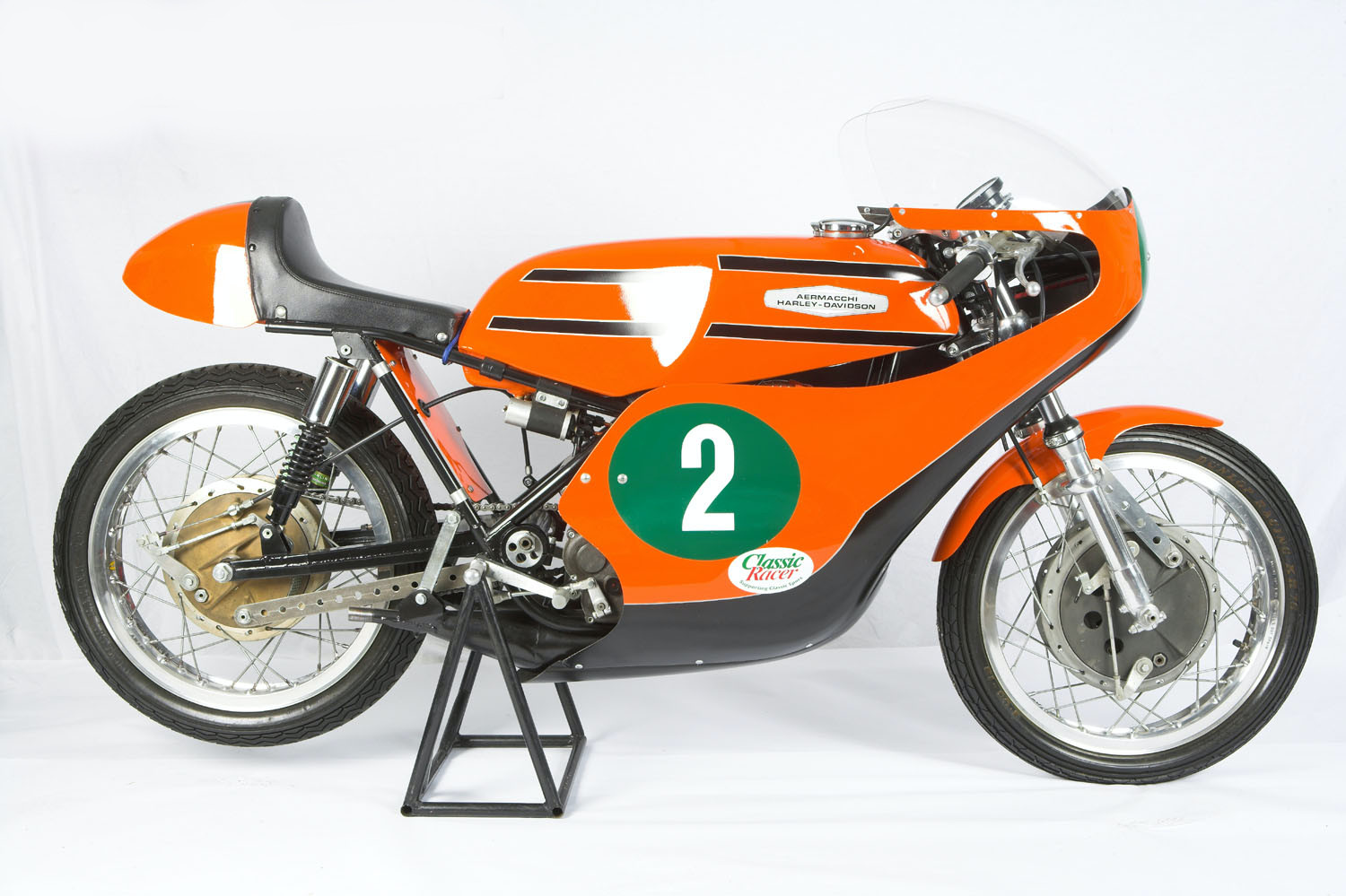 in a mass crash at Monza on May 20, 1973, which was caused by an oil leak after the previous 350 race. Ironically, it is said that it was Walter Villa’s Benelli who spilled the oil. It was one of the worst accidents in the history of motorcycle racing. With Walter Villa as driver, Harley Davidson took the World title in the 250 class in 1974, 1975 and 1976! In 1976 he also won the 350 class. In 1977 things went worse, but a 2nd place for Franco Uncini was not bad.
in a mass crash at Monza on May 20, 1973, which was caused by an oil leak after the previous 350 race. Ironically, it is said that it was Walter Villa’s Benelli who spilled the oil. It was one of the worst accidents in the history of motorcycle racing. With Walter Villa as driver, Harley Davidson took the World title in the 250 class in 1974, 1975 and 1976! In 1976 he also won the 350 class. In 1977 things went worse, but a 2nd place for Franco Uncini was not bad.
1978 HD Cagiva
HD (read AMF) had now lost interest in the Italian factory. They didn’t invest enough for new development. The quality of the motorcycles had deteriorated in the mid-seventies, and they obviously got a bad reputation. In 1974, as many as 45,000 motorcycles were manufactured. With the help of Villa's success, they tried to sell a single-cylinder 250 that did not have much in common with Villa's machine. It was badly received and the machine sold poorly. They were soon having problems by warranty issues on the unreliable motorcycles. The quality was soon improved, but it was too late. In 1978, the quality had increased significantly, but in May of the same year it became clear that HD wanted to get rid of its Italian factory. Sales had fallen catastrophically. In September it was announced that the factory would be taken over by the Castiglioni brothers. Then we are back to the 7th of October when Cagiva is formed. The Castiglioni brothers had a vision. They would make the motorcycle brand Cagiva world famous! The brothers had a passion for motorcycles and it was quite natural to buy the motorcycle factory for sale in their own hometown. The purchase price is said to have been a very low 2 million euros. HD had cut its workforce to 500 people when it shut down production. The C brothers started with only 130 workers, of whom over 1/4 worked with development! Cagiva's name (C.G.V. and the elephant) had already been seen on the racetracks in 1978 when a 500-class Suzuki private team (Team Life) was sponsored with no other than Marco Lucchinelli as driver. In principle, Cagiva's GP team was born before buying the factory! They had also tried to buy MV Agusta's racing team a few years earlier! At the beginning, the motorcycles were called HD Cagiva and they continued the production of the small two-strokes of up to 350 cc of the parts that were basically on the shelf. They even took HD's "number one" logo, changed the American colors to Italian and the name from Harley Davidson to Cagiva. Cagiva's symbol, the elephant was inherited from CGV. The aircraft manufacturer Aermacchi continued to live side by side with Cagiva but soon abandoned the premises, which have now fallen into disrepair and are to be demolished. It merged with other aircraft manufacturers, including Agusta-Bell and today has the common name Leonardo.
1979-1985 Addition 1: Ducati
Because the factory was bought cheaply, including a lot of parts that in some cases lasted many years, it did not take long before Cagiva started to make a profit. HD had already invested a lot in increasing the quality. It founded Cagiva's success. The SST 125, which was a further development of the Rapido from 1967, became the best-selling motorcycle in Italy between 1979 and 1982. In 1979, Cagiva manufactured 9000 motorcycles. In 1980 they made 13,000 and in 1982 they were up to 40,000! They also started to loan a lot of money for new development and expansion. Among other things they developed an off-road with a four-stroke engine from Rotax, Ala Rossa. A prototype based on Villa's GP machine, 250 DSTT with a 48 hp engine, was shown at the Milan Motor Show in 1979, but never came into production. In 1980, they started their 500 GP team with Virginio Ferrari as driver. The first bike was called C1 and did not go very fast. In 1981, they broke the speed record for 125’s (256.8 and 248.5 km/h) with a machine called the Ala d'Oro. Cagiva's development department now consisted of people from Aermacchi (Mascheroni and Milani) and MV Agusta. They also received outside help from the two-stroke specialists, the German Peter Durr and the Dutch Jan Thiel and Jan Witteveen. Most motorcycles were sold on the domestic protected market. At this time, imports of motorcycles up to 350 cc were prohibited in Italy. In 1982, they wanted to broaden their horizons. Among other things, they were interested in buying Hesketh in England, but they were discouraged when they saw the factory in real life. VM-group wanted to get rid of motorcycle production at Ducati and contacted Cagiva, which thus led to the famous agreement on June 2, 1983 and eventually the takeover on May 1, 1985. The 500 team continued with drivers such as Jon Ekerhold (1982), Virginio Ferrari (1983), Herve Monieu (1984), Marco Lucchinelli (1985) and Juan Garriga (1986). However, without success. In 1985, Tony Rutter won the F2 class on the Isle Of Man with a factory Ducati TT2. The factory had sent a mechanic in a van with large Cagiva stickers. Later he also won the F2 World Cup for the fourth time. Cagiva also developed a new Moto cross machine that was introduced in 1980. It quickly became successful. In 1985, Pekka Vehkonen won the World Championship in the 125 cc class and the following year, David Strijbos repeated the success.

1986 Addition 2: Husqvarna
Production of Mille ceases and 350/650 Indiana and 750 Paso are born. The last Alazzurra bikes are built in Varese and in Bologna where the SS & GT were built. The Ducati factory's capacity will be expanded with a new painting plant. Elefant will have an enlarged 750 cc engine, 750 F1 will have Forcella Italian fork and, like the other bikes, a new Ducati logo designed with Cagiva's font and a Cagiva elephant. A tuned and high spec version of F1, Montjuich, is produced in a limited edition. The C. brothers surprise again on April 1 by buying Husqvarna's motorcycles division from Electrolux. The name and dealer network in the USA are included in the purchase. A very smart move. A new frame factory is being built in Varese, jointly for Cagiva, Ducati and Husqvarna. Marco Lucchinelli wins this year's first F1 race on a Ducati TT1. Cagiva has already expanded and a licensed production is started in Brazil and Argentina. Ducati is reintroduced to the Italian market after being absent for a few years. The year before, only 171 Ducati were registered in Italy! Ducati's largest market is Japan, where they sell a special 400 cc model (400 F3), a smaller F1 that is also sold as a 350 F3 in Italy and the Alazzurra 400 GT. Cagiva Commerciale is formed to handle sales and marketing of the Cagiva Group's motorcycles. Massimo Bordi designs a new four valve cylinder head with Desmo for the 750 Pantah engine. Taglioni, who returned to the factory sporadically after Cagiva's takeover, also helps with the design work. The machine debuted at the Bol d'Or 24-hour race in 1986. Even Fabio is on site and smokes as usual in the paddock. The machine runs fast, but have to retire with an engine failure. However, it is not a major defeat because the engine was completed only a few days before the race.
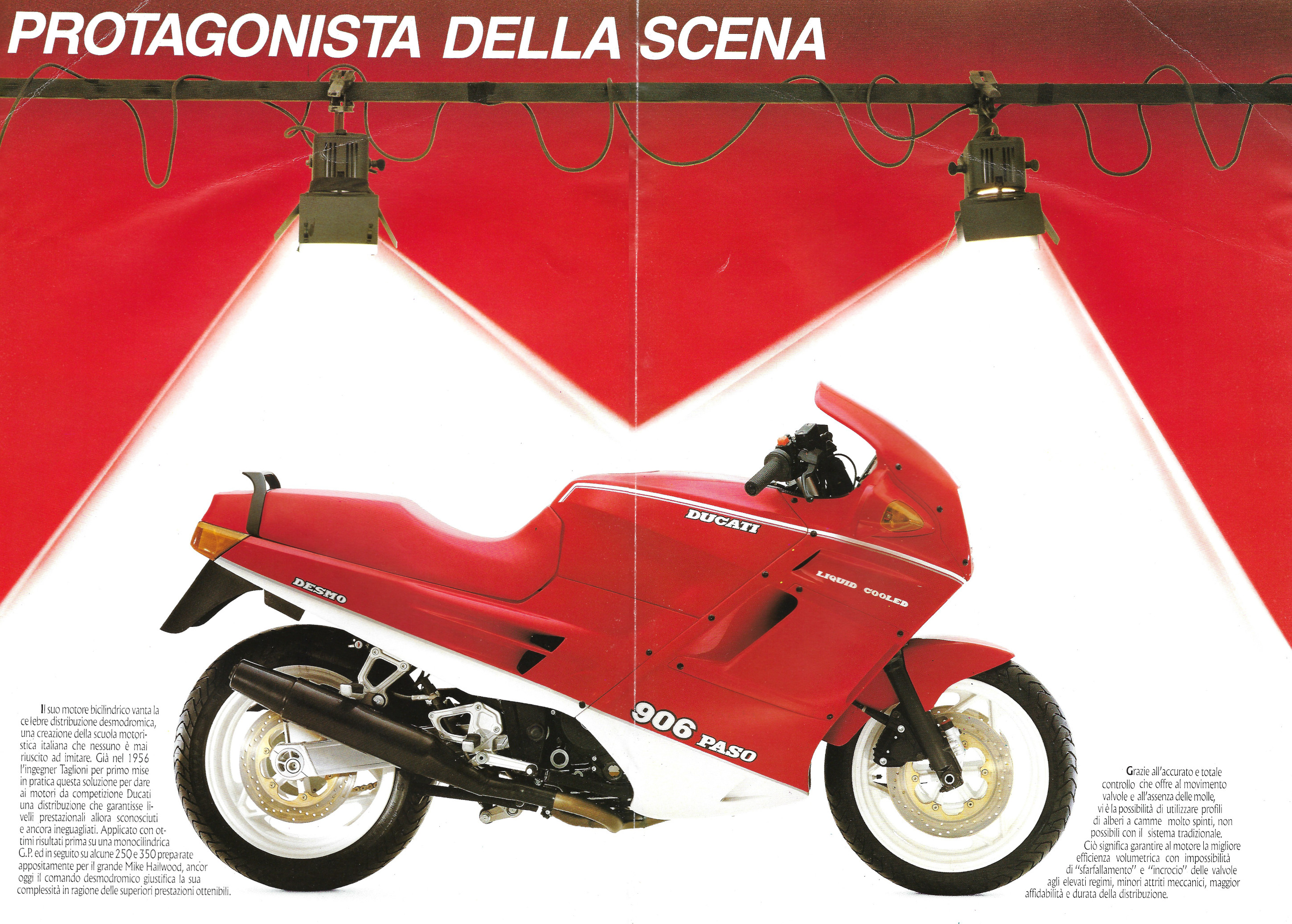
1987 Addition 3: Moto Morini
At the beginning of the year, the Ducati 851 will not make its debut on the road racing track, but in Paris Dakar! However, the engine has standard 2-valve heads. Cagiva buys Moto Morini, a small factory in Bologna, from Gabrielle Morini, probably the only woman who owned a motorcycle factory. Included in the purchase is the legendary designer Franco Lambertini. He had started his career at Ferrari. In 1970, he started with Moto Morini and designed, among other things, their famous V-twins 3 1/2 and 500. When Cagiva buys Moto Morini, Lambertini has just developed a prototype, a water-cooled 4-valve V-twin of 750 cc and 67 degrees between the cylinders. The engine weighs only 50 kg and is put to a 20-hour hard test in Ducati's dyno. When it turns out that the power on this early prototype is ten horsepower more than on the Ducati of the same size, it is said that the Ducati people around the dyno ordred "shut down everything, we do not want to see this engine anymore". The project is stopped and Lambertini will soon leave Moto Morini to return when the brand was reborn in the early 2000’s.

The successor to Montjuich is called Laguna Seca and is a bit of a dissapointment. It's a two-seater! In March, Marco Lucchinelli wins the BOTT race at Daytona. The engine has grown to 851 cc. At the same time, new stronger engine cases are ready. A winner is born. A street version, 851 Strada, is presented at the Milan Motor Show. After the victory, Marco records his first, and hopefully only 45 rpm musical record: Lei Cagiva, Lui Ducati! Raymond Roche is the main driver in Cagiva's 500 team and places himself 7th in the Italian GP at Monza. Cagiva 125 Freccia is manufactured under license in Taiwan. At the end of the year, the last F1’s are manufactured.
1988 851
Laguna Seca is being replaced by the more high spec Santa Monica. The 851 is to be sold as both a street machine and a race bike. The F1 is replaced by 750 Sport with the same engine as Paso. It is not as raw at all and had sluggish steering characteristics. It received a cold reception and did not sell very well. What is also new is that the adjustment of the valve clearance on the 2-valves has been simplified by a clever little clip, which means that you do not have to remove the lower rocker arm shaft when adjusting the valve. After the summer, the new water-cooled 906 Paso (904 cc) is introduced. Randy Mamola drives the Cagiva in the 500 class, as does Raymond Roche on the most beautiful Cagiva racer ever, the V588. At Spa, they get on the podium for the first time through a 3rd place by Randy.
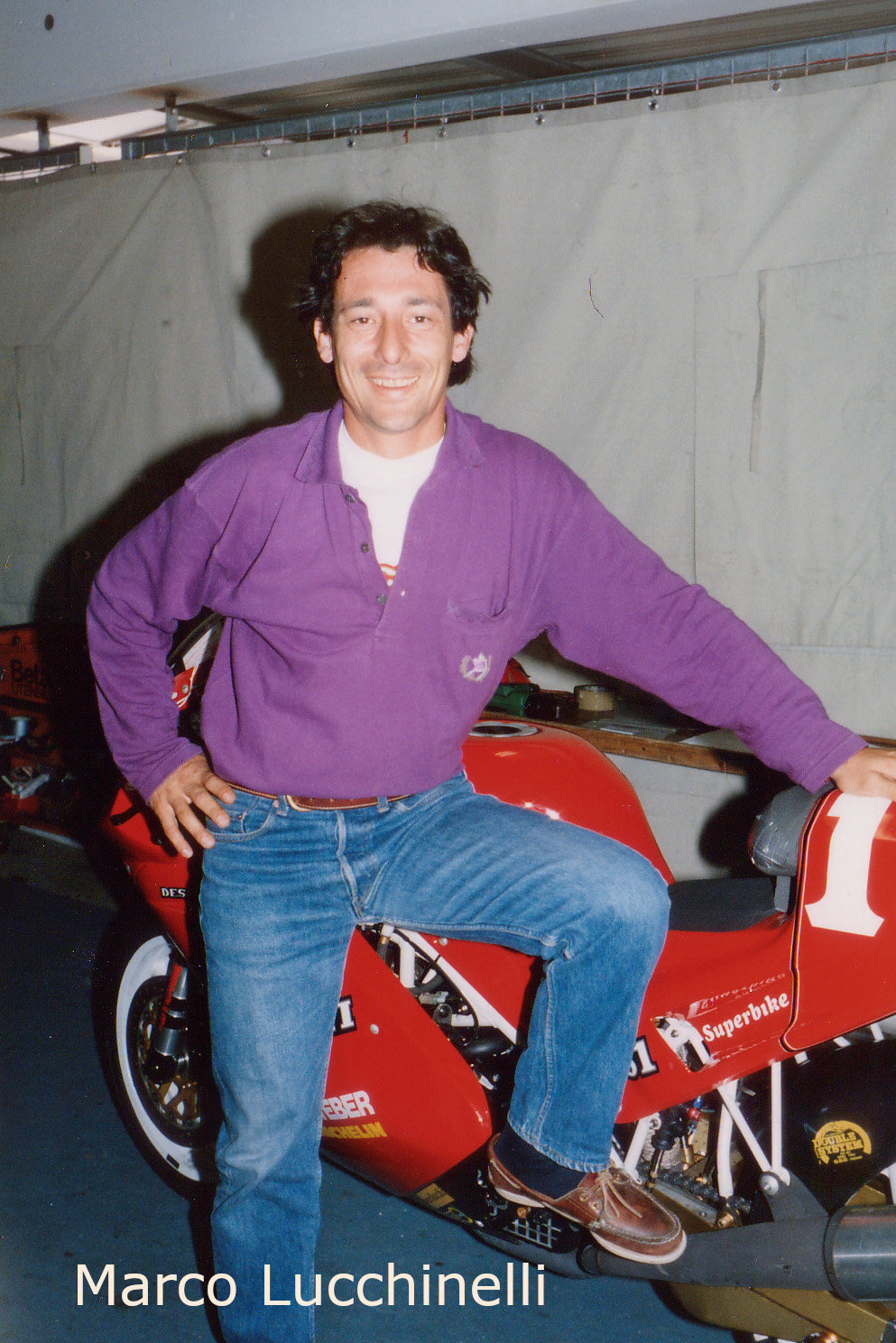
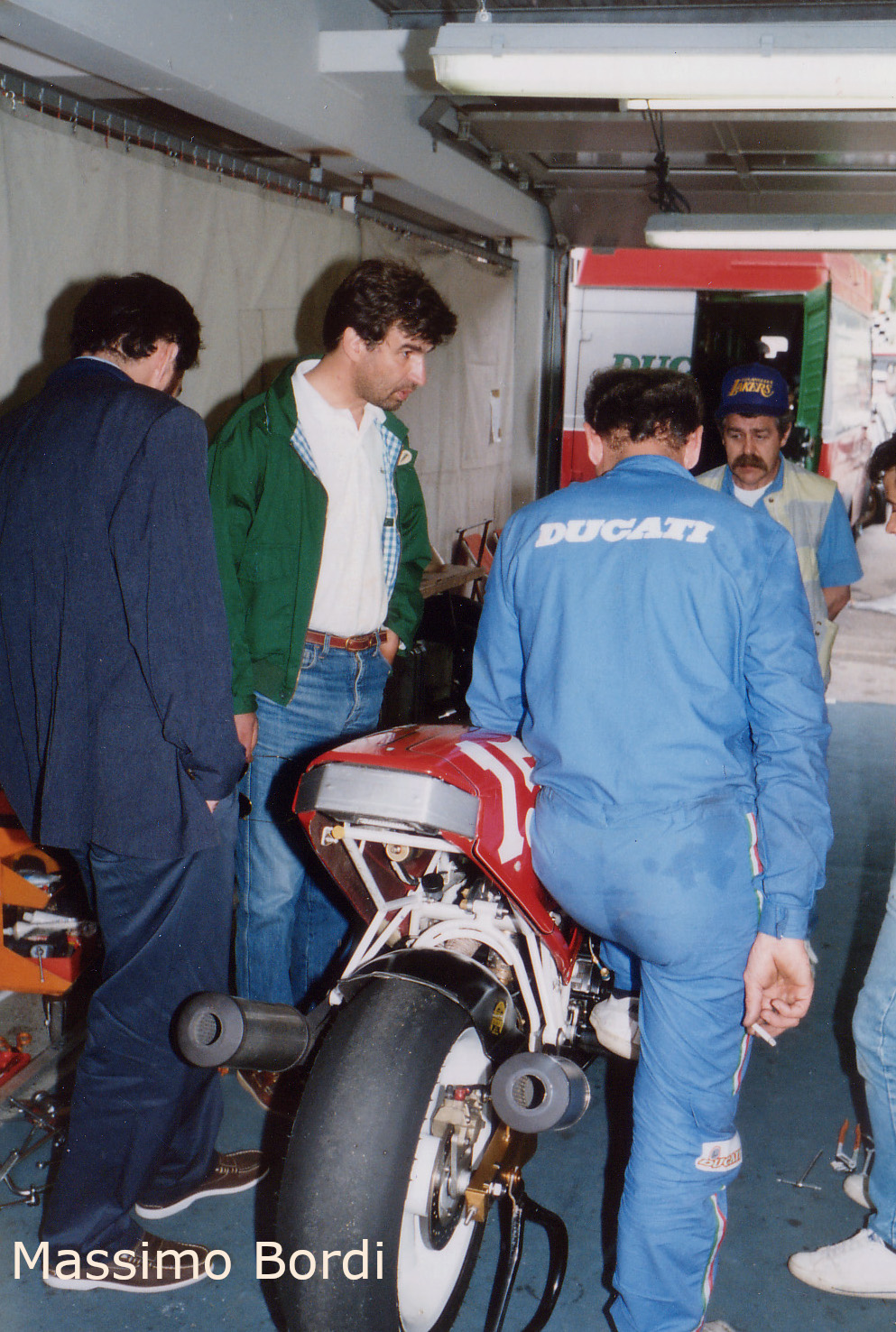 Randy eventually finishes in 12th place and Roche in 20th after the Pirelli tires didn't measure up. They also line up in the 125 class with Pier Paulo Bianchi and Ian McConnachie, but without much success. In the premiere of the first ever World Championship Superbike race in Donington, Marco Lucchinelli wins at a factory 888. At the same time, the press is praising the street model, 851 Strada. This is the beginning of something big!
Randy eventually finishes in 12th place and Roche in 20th after the Pirelli tires didn't measure up. They also line up in the 125 class with Pier Paulo Bianchi and Ian McConnachie, but without much success. In the premiere of the first ever World Championship Superbike race in Donington, Marco Lucchinelli wins at a factory 888. At the same time, the press is praising the street model, 851 Strada. This is the beginning of something big!
1989 Rumors of an in line four in collaboration with Ferrari
Randy becomes the sole driver in the 500 and Roche manages Ducati in Superbike with Giancarlo Falappa as second driver. Randy gets a Testarossa from the C. brothers in advance (the intention was that he would get it when he won a race). Lucky retires and becomes team manager of Ducati's super bike team. Now everything would point upwards. At least for Ducati. 1989 the 900 Supersport is introduced. It will be the platform for the new and very successful 750 and 900 SS models that would appear in 1991. During the year it will be known that Cagiva, with the help of Ferrari, is developing a new in line four (it is the so-called C4 that was later presented as MV Agusta). Raymond Roche comes 3rd in the Superbike World Championship. There is no progress for Randy in the 500 GP.
1990 Addition 4: Mini Moke
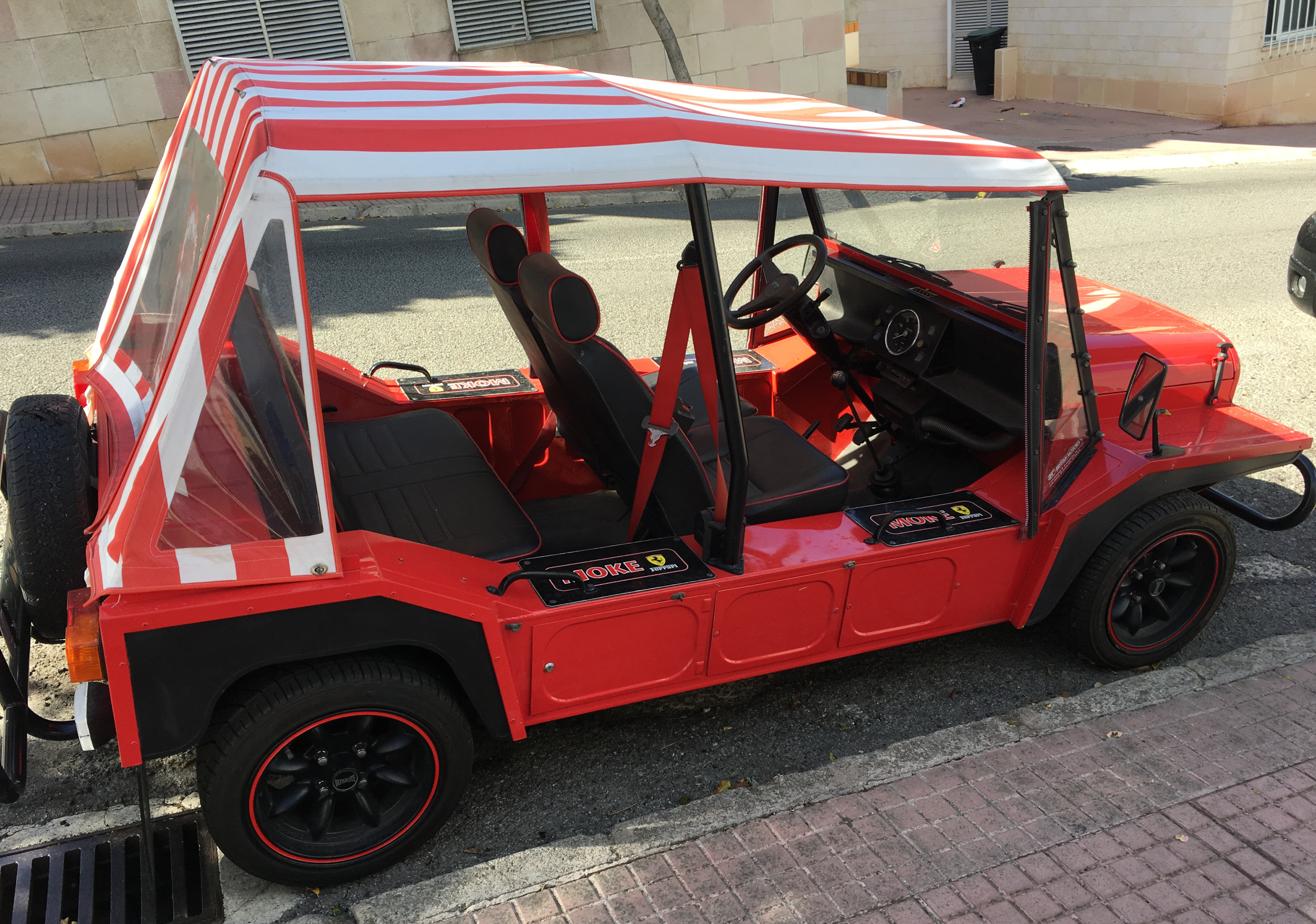
Edi Orioli wins Paris Dakar on a Cagiva/Ducati. Randy Mamola, Alexandre Barros and Ron Haslam drives Cagiva in the 500 GP where Virginio Ferrari becomes team manager. Rumor is said that the new 4-cylinder Cagiva will be called Ferrari Cagiva. Rumors are also starting to buzz about a new single-cylinder Ducati. The 888 is to be sold to expectant buyers. The Elefant gets a 904 cc engine. 906 becomes 907 IE and gets fuel injection and 17" wheels. Bimota starts selling Tesi, a Ducati with hub steering. Cagiva starts looking for a motorcycle factory in England and is close to buying Norton! The sales director Luigi Giacometti at Cagiva says that Cagiva’s in line four will be presented in 1991. The C brothers buy Mini Moke, a factory that produces a terrain version of the Austin/Morris Mini! What became of this is unclear. It is said that a number of Mini Mokes were produced in Portugal before the production equipment was moved to Bologna. Fabio Taglioni turns 70. Cagiva is struggling in the 500 GP (despite attempts with carbon fiber frame, among other things) and is said to be quitting. At the end of the year, Cagiva announces that the new four will start selling at end of 1991. Raymond Roche wins the Superbike World Championship on the Ducati 888!
1991 Adriano Ducati dies
The 750 and 900 SS models are introduced. There are two important reasons why SS models will be so popular. On the one hand, it is the excellent quality and stylish design. Then it is that Ducati has suddenly started to get a good reputation and a huge positive response in the motorcycle press. It has not happened before. At least not to this extent. In the past they were acclaimed for road holding, engine and sound. But the quality in general had been downplayed. It was often unjustified criticism, but in some details one could agree. Bolts and chrome rusted and sometimes there were problems with the electrical system. On the SS models, however, there was basically nothing to whine about! The finish was excellent. The second reason for the complete reversal of the press opinion is the most important. Ducati 851 and 888! Eddie Lawson signs contract with Cagiva for 2.2 million euros. Cagiva starts a collaboration with CZ in Czechoslovakia. At the end of the year, 900 Superlight will be introduced. Ducati wins a double victory in the Superbike World Championship by Doug Polen winning on a Fast By Ferracci Ducati before Raymond Roche on a factory Ducati. Eddie Lawson will be 6th in the 500 GP. At the Milan Motor Show, the 92 Superlight and Cagiva Mito Eddie Lawson Replica are presented! Premiere for 350 SS and 400 SS (the latter for the Japanese market). On November 25, Adriano Ducati, one of the founders of the Ducati factory, dies. On December 6, Marco Lucchinelli was arrested by the Bologna police after smuggling cocaine from Peru to Germany via Italy.
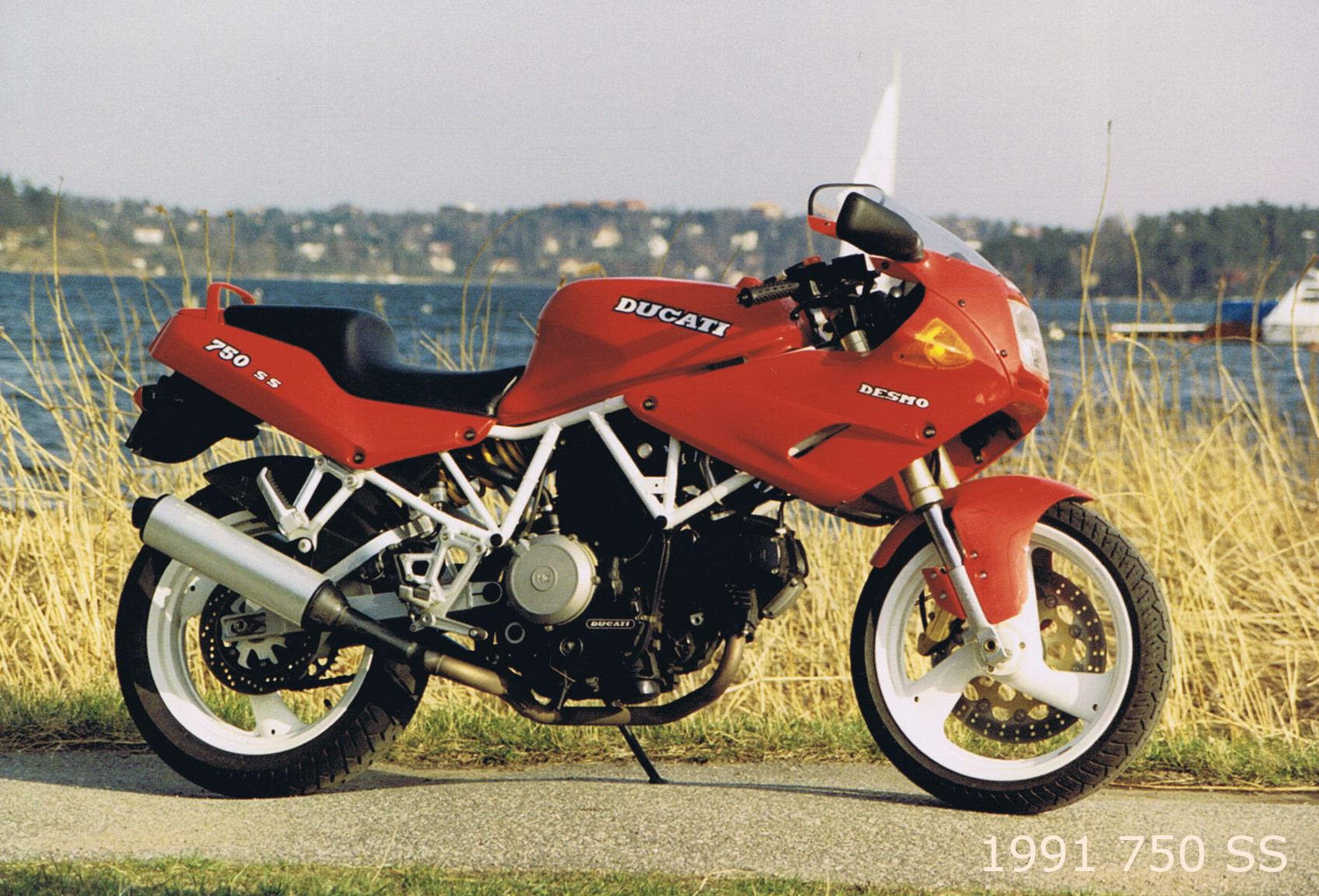
1992 Addition 5: MV Agusta 750 SS gets back the old wet clutch from 600/650 Pantah. At the factory, a second assembly line is built and will basically double the capacity. Giacomo Agostini will be the team manager in the 500 GP. Eddie and Barros stays. The 500's engines are still being developed by Ezio Mascheroni, who developed Paso’s and Villa's engines in the 70's. Franco Uncini becomes team manager in the Superbike series. On Tuesday, March 10, Cagiva buys the right to use the name MV Agusta. 1 million euros is said to have been paid to Count Ricardo Agusta. The agreement has nothing to do with Agusta's helicopter production. It is a logical investment. With such a name on a 4-cylinder top model, they can sell it at a higher price level. But no one has yet seen any 4-cylinder engine. Ducati 502 Supermono is introduced. The most beautiful Ducati ever! In the Hungarian GP, Lawson takes the first victory for Cagiva in a race on a drying track where the choice of tires is crucial. Alan Cathcart's pictures of a Cagiva four, taken in the rush hour traffic in Bologna, are spread all over the world! At the Cologne Motorcycle Fair, Monster, Supermono is shown, but not a glimpse of either the 916 (as it is rumored) or the Cagiva four. Lawson ends up 9th in the 500 GP class. Doug Polen wins the Superbike World Championship on a FBF-Ducati, before Roche. Falappa comes 4th. A fantastic season for Ducati.
1993 Addition 6: CZ
Centro Ricerche Cagiva is built up in San Marino. The boss will be Massimo Tamburini with Pierre Terblanche from Volkswagen and Miguel Angel Galluzzi from Ford as designers. Uncini gets fired from Ducati's factory team after he fired Falappa. Falappa returns and Raymond Roche becomes the team manager. Roche is replaced by Carl Fogarty as driver. Scott Russel on a Kawasaki wins the Superbike World Championship before Fogarty. Fogarty succeeds in England's 500 GP where he steers a Cagiva 593 in 3rd place, despite running out of fuel in the last corner! Davide Tardozzi becomes team manager in another Ducati team. Cagiva buys shares in Czech CZ (unclear how much). The last Moto Morini 501 Excalibur is assembled at the Ducati factory, where most of the Morini bikes have been built since 1989. In the old Moto Morini factory, a new business is started: they start manufacturing mourning clothes! Marco Lucchinelli receives a five-year suspended sentence for possession of heavy drugs and must appear before the Bologna police every morning. Mat Mladin and Doug Chandler drives the Cagiva in 500 GP, but it does not go well. John Kocinski jumps in into the middle of the season and starts with two 4th places and one victory! The C. brothers explains to an English motorcycle journalist that the new four cylinder motorcycle will start selling in just over a year. Massimo Bordi says that "the Japanese will bang their heads against the wall when they see how we built the engine". So in retrospect, one wonders who banged their heads against the wall? Until then, it had cost 7 million euros in development costs. Sneak peeks of 916 are presented and it is manufactured during the first year by Cagiva in Varese due to a fire in the Ducati factory’s painting department. At the Milan Fair, 916 is displayed and gets huge attention. The 600 Pantah resurfaces after ten years as an engine in the 600 SS and 600 Monster. No four in sight. At the end of the year, someone looks at the factory and observes that they have turned the cylinder head backwards! However, this will be corrected later…
1994 Cagiva withdraws from the 500 World Championship series after their best season
Edi Orioli wins Paris-Dakar again on a Cagiva Elefant. A young Italian named Valentino Rossi becomes Italian champion in the 125 cc class on a Cagiva Mito. Pictures of the Cagiva four are displayed. John Kocinski and Doug Chandler drives the Cagiva in the 500 World Championship. It starts very well. Kocinski wins this year's first race in Australia. In addition, Aprilia wins in both the 250 and 125 class in the same competition, all-Italian! After winning several races, Kocinski finishes in an honorable 3rd place in the World Championship. It looks good for next season, but Cagiva is retiring! Rumors of payment difficulties are now circulating. There are rumors of lots of almost finished Ducati waiting for parts. Subcontractors refuse to deliver as they do not get paid by Cagiva/Ducati! At the end of the year, it is rumored that Cagiva has taken out a large loan to cope with its urgent financial situation. Carl Fogarty does what he has to do and wins the Superbike World Championship for the factory team that has Virginio Ferrari as team manager. Falappa is seriously injured after a dangerous crash in Spain. Ducati presents the news for 1995: 748 SP, 748 Biposto, 916 Biposto and 916 Racing. Ducati Senna is introduced as a 916 top model but is put on ice after Senna's tragic death crash on May 1 at Monza. Cagiva is investing large sums of money in building a new automatic paint plant and a new 3rd production line. There are still rumors of production disruptions due to "annoyed" subcontractors, including Öhlins. According to hot rumors, Cagiva's four are now at a full 920 cc and will be shown at the Milan Motor Show the following year. The C brothers also say that they are withdrawing in the 500 to concentrate on the four, which they will start competing with in 1996.
1995 Delivery problems and no four
Even more pictures are presented on the in line four. Pictures are circulating in the motorcycle press from test runs at Mugello. All indications are that the four will be shown at the Milan Motor Show, but hey, it does not show up. Then, instead, new rumors emerge in the United States that the four was discontinued and replaced by a straight 3 and a V4. The rumor is supposed to come from Eraldo Ferracci! Even more hassle with Ducati's deliveries as production is sometimes down. In the world, customers are waiting for their Ducati’s to be delivered! Now the problems are starting to become obvious when Cagiva says that they want to introduce Ducati in the US stock exchange market! Carl Fogarty wins the Superbike World Championship again but leaves for Honda! Ducati 916 Senna begins production. What had gone wrong? The company's value was increased through various company acquisitions. In this way, it was possible to borrow money for more company acquisitions and the development of, among other things, the in line four. This went well before the crisis of the 1990s hit and the banks knocked on the door and wanted more security for the loans. The value of the company's assets had probably decreased significantly during these crisis years.
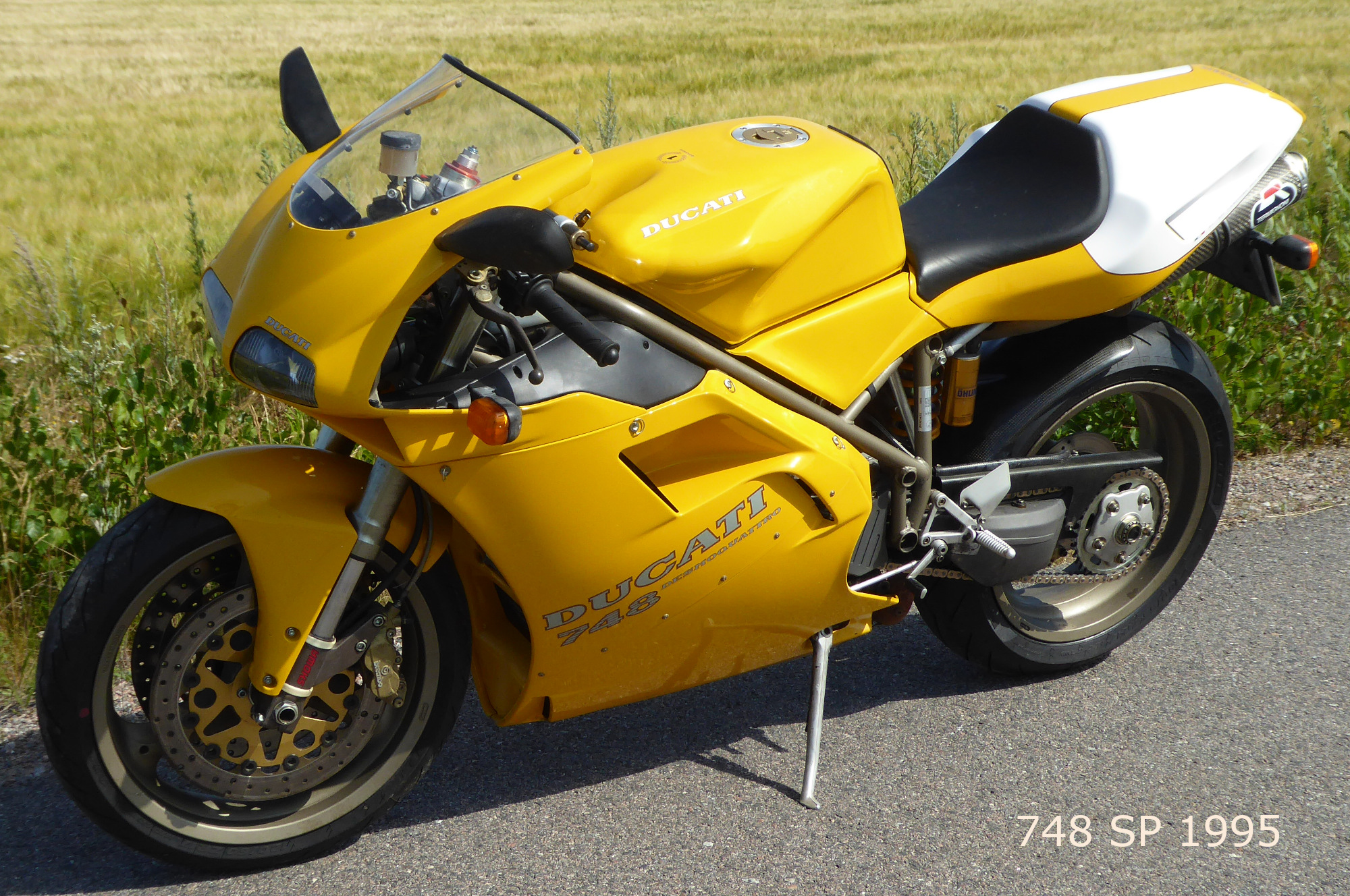
1996 Who is in charge over the Cappucino machine?
John Kocinski drives factory Ducati in the Superbike World Championship, but Troy Corser wins in the end on a Team Promotor Ducati. A big deal where half of Ducati is to be sold to the American businessman Sam Zell is in full swing. Zell is a major motorcycle enthusiast in Chicago who, among other things, owns 30 Ducatis! He is said he had withdrawn when it dawned on him that he could not even be sure he would be permitted to use the Ducati factory's cappuccino machine! Production at the Ducati factory is down at the beginning of the year. Lack of money says the rumor, inventory says a spokesman from the factory! Not hard to guess what is true. The money problems mean that Cagiva is strangling the entire group by not producing motorcycles and thus no money is flowing in. Something has to happen, and fast, to solve the problems. On September 30, Cagiva sells the entire Ducati Meccanica. 49% is sold to the Castiglioni brothers, 49% to the American company Texas Pacific Group (for $225 million) and the remainder (2%) is deposited jointly with a later option that allows Castiglioni to buy over this part. In this way, Ducati is completely removed from Cagiva's organization. That was a way to get healthy money for both Ducati and Cagiva. Ducati presents the sports tourer ST2 at the Cologne Motorcycle Fair, otherwise no major news.
1997 MV Agusta F4 is presented
The four-cylinder motorcycle is finally presented under the name MV Agusta F4 750. This was the last year the C brothers were involved in Ducati and you can sum it all up that during these thirteen years they managed to build Ducati into a brand with a nice model flora and very good reputation. Owning MV Agusta would have been the C brothers' big goal and the question is whether it was so successful. Could they make the same journey with MV as they did with Ducati? During the year, they get rid of CZ whose motorcycle production ceases.
1998 Ducati sold
TPG buys the remaining 49 + 2 percent of the shares and now takes over the entire Ducati. Included in the purchase is the more or less dormant brand Moto Morini. Therefore, we leave Ducati here and see what happened to the C brothers and their activities. The money received from the sale of Ducati does not cover Cagiva's debts. They have to do something.
1999 The Castiglioni brothers go their separate ways
Cagiva is reconstructed and the main company is named MV Agusta Motor where Cagiva and Husqvarna remain as brands. The C brothers split the company between themselves . Gianfranco takes over Castiglioni Giovanni Varese S.p.a. and soon forms Casti S.p.a. as a parent company and acquires a number of companies in everything from hotel operations to various mechanical companies. Cagiva continues on its own swaying legs with Claudio in charge.
2000's The crisis continues
When ties with Ducati were broken, they turned to Suzuki as an engine supplier. Suzuki's V-twin will be a source of power for new motorcycles such as the Raptor and Grand Canyon. The 125 Mito remains as well as other models with the 125 cc engine. Husqvarna is also still there and the company are still struggling with tangled finances. In 2001, Claudio tries to sell 20% of the company to Piaggio without success. In 2002, the company went bankrupt and has been under bankruptcy management for some time. In 2004, MV Agusta F4 1000 and Brutale S. were presented. In the same year, the Malaysian company Proton enters with capital and acquires 57.7% of the company for EUR 70 million. Castiglioni retains 37.25%, Massimo Tamburini 2% and Electrolux (which owns the Husqvarna name) 3%. Proton also pays the company's debts of 107 million Euros. The company is saved! The production volume is now down to 18,000 MV Agusta, Cagiva and Husqvarna motorcycles per year. In December 2005, Proton sold its stake to GEVI SpA, a company based in Genoa. The purchase price is supposed to be 1 Euro! Behind the scenes, Claudio Castiglioni is said to be. In October 2007, Husqvarna is sold to BMW, but production will remain in Varese until 2013 when KTM takes over the name.
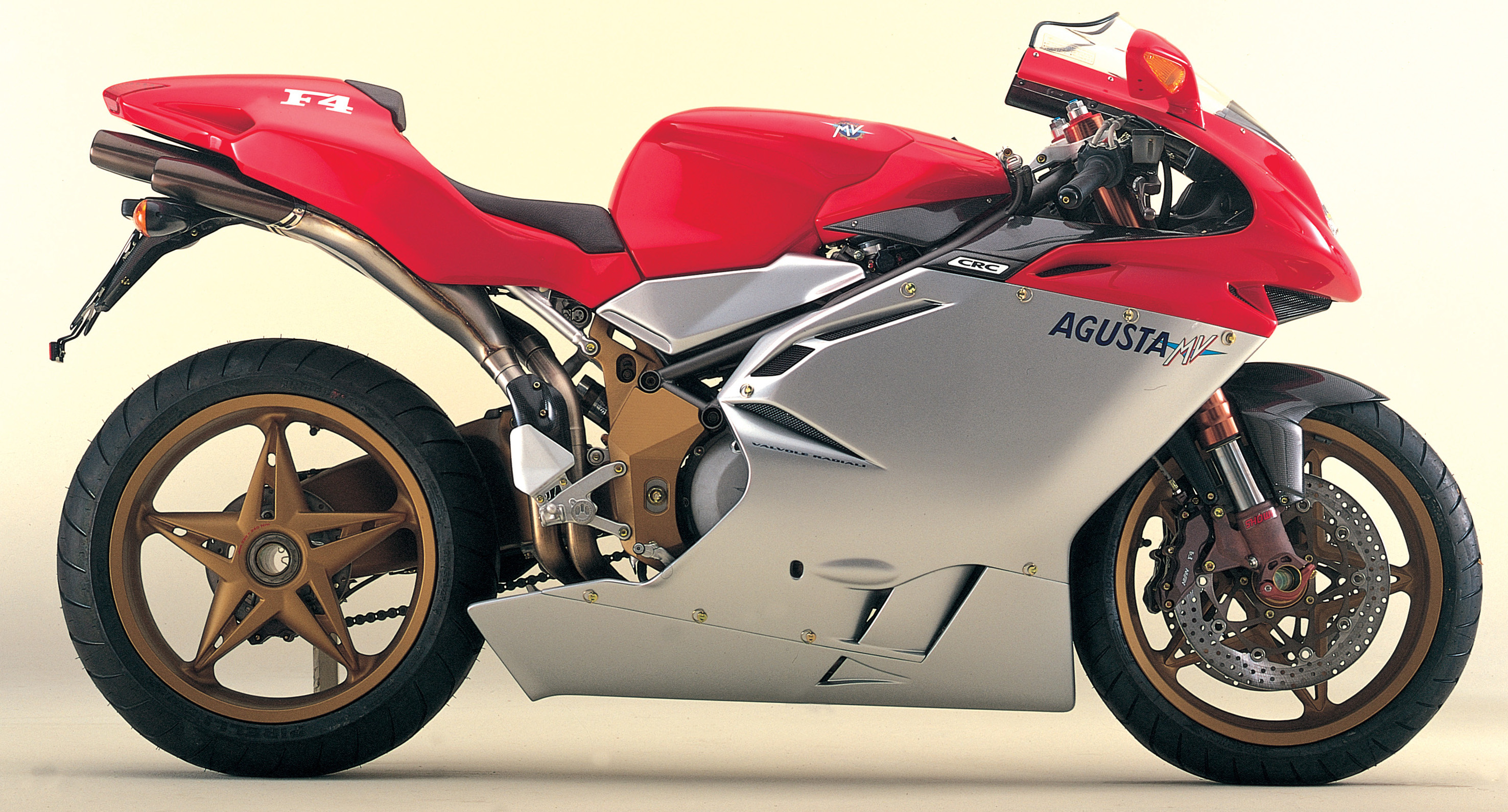
Harley Davidson returns
July 11, 2008 the big news is released: Harley Davidson buys MV Agusta for 70 million Euros! The circle is complete, Harley Davidson are back in Varese. Claudio Castiglioni is still at the helm. However, HD will soon get cold feet. In December of the same year, Massimo Tamburini retires and is succeeded by Pier Paolo Bianchi (who drove the Cagiva in the GP 125 cc class in 1988). The Englishman Adrian Morton, Senior Designer, holds the drawing pen for MV Agusta's new models after having been with the company since 1995.
The Castiglioni's last decade in charge
On August 6, 2010, Claudio Castiglioni buys back the company from Harley Davidson! Buy is perhaps the wrong word. It is said he have received 20 million Euros to take back the company and Harley Davidson writes off the company's losses which amount to a breathtaking 162.7 million dollars! Massimo Bordi steps in after working for tractor manufacturer SAME Deutz-Fahr (Lamborghini tractors) and takes over as technical director. Claudio's son, Giovanni, takes over as CEO of the company. It is rumored that Claudio has suffered from cancer.
In 2011, Claudio Castiglioni dies, only 64 years old. 2013 saw the presentation of the MV Agusta F3, a 675 and 800 cc three-cylinder machine designed by Morton. The engine was designed by Ezio Mascheroni who, if you're keeping up, was one of the men behind the 500 GP venture in the 90s and the success of Harley Davidson in the 70s.
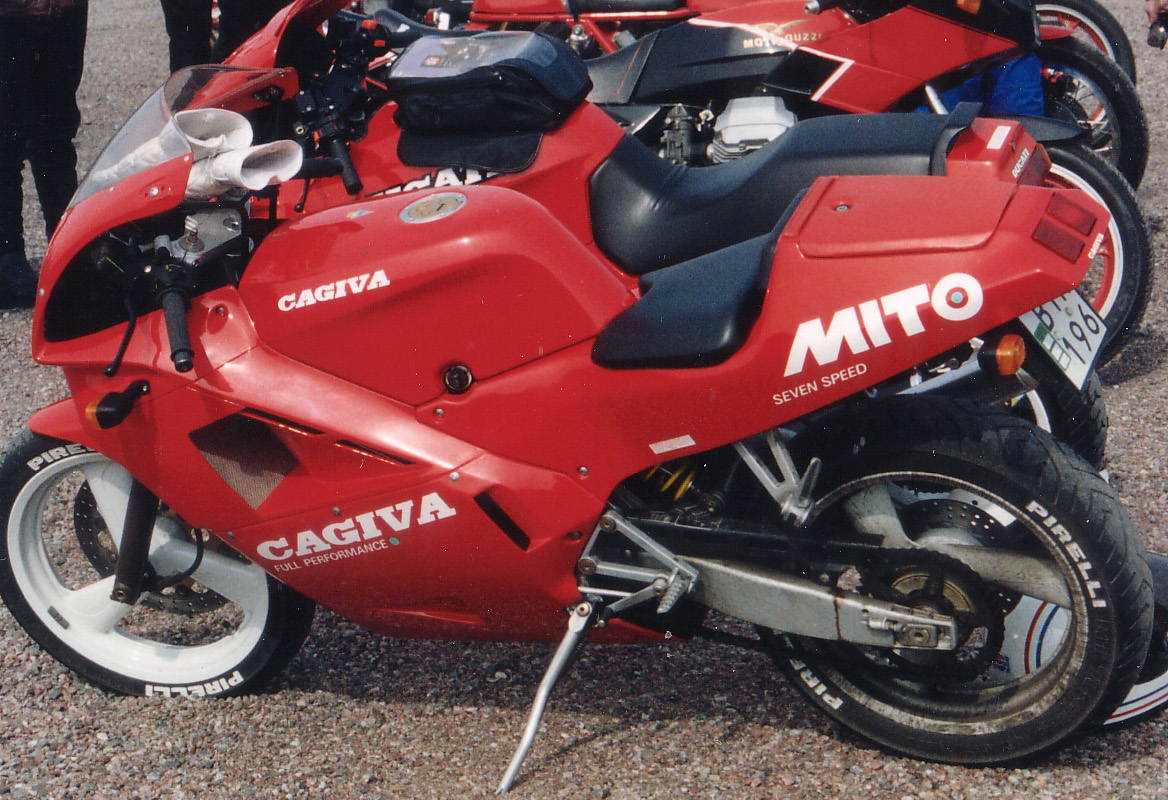
In 2012, production of the Cagiva Mito, an icon in the 125 cc class, is discontinued. The Cagiva name disappears and thus also the collaboration with Suzuki as engine supplier. In 2013, Massimo Bordi quits MV Agusta for unclear reasons and starts working with agricultural machinery at Maschio Gaspardo as Chief Executive Officer.
In 2014, Mercedes buys 25% of the company as a response to Audi's purchase of Ducati. In the same year, strange things begin to happen in Varese. Do you remember Gianfranco, the older Castiglioni brother? He had built an empire of businesses. The parent company is called Casti SpA. Under Casti there is also Castiglioni Giovanni Varese Spa. and around 20 other companies, including the legendary Isotta Fraschini. But not everything seems to be going well in the companies. The tax authority discovers that fake invoices were sent between the companies, which thereby avoided paying taxes on a breathtaking 1.2 billion Euros! Gianfranco is put under house arrest together with his adult children and the companies are put under state administration in order to get money back to the treasury by selling the companies.
The taxman's eyes are also directed at MV Agusta, where Giovanni is sentenced to 6 months in prison for tax offences. Giovanni is also accused of falsely stating that he was a resident of Switzerland. He would have done this to get a lower tax. However, this is questioned by the prosecutor after a fresh Mozzarella cheese was found in Giovanni's house in Varese which indicated that it was where he lived! He is later acquitted in a higher instance.
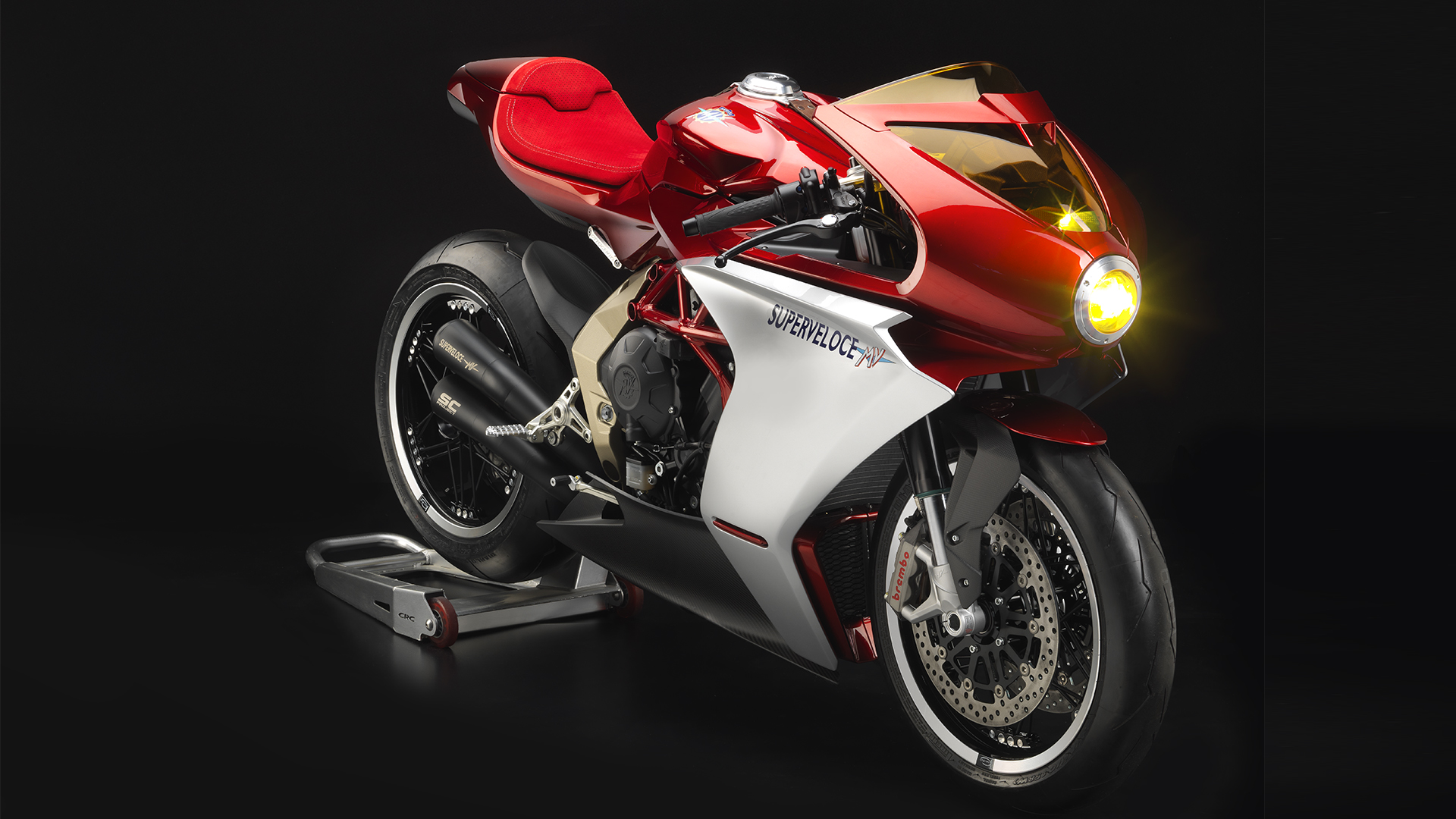
There was also a family feud in court when it emerged that Gianfranco sold a Ferrari Dino 246 GT that, according to Giovanni and his mother, he jointly owned with Claudio and then sold and kept the money himself. 2014 was also the year Massimo Tamburini passed away, the legend behind the Ducati 916 and MV Agusta F4, among others.
2017 MV Agusta buys back the 25 percent of Mercedes as the collaboration did not work at all. 49% of the company is taken over by ComSar Invest which is part of the Black Ocean Group owned by the Russian oligarch Timur Sardarov. They come in with fresh new money. During this time, MV Agusta has been plagued with major quality problems, which have affected both finances and reputation.
On October 1, 2019, Sardarov takes over as CEO and it becomes clear that Giovanni Castiglioni will have a smaller role in the company as an advisor. ComSar Invest takes over 100% of the company and the Castiglioni family has now lost control of all their companies. Massimo Bordi returns as executive vice president and the company presents a five-year plan. In 2019, the production volume is a low 3,000 machines. It is to be increased by 3000 every year and a collaboration has been started with Chinese Loncin Motor Co where they will produce 350 cc and 500 cc twin cylinder engines developed by MV Agusta. There is also talk of electric bicycles and later electric motorcycles. It was stated that the Cagiva may be resurrected as an electric motorcycle. During the year, MV Agusta registers the name Elefant.
2020 is a year marked by the terrible Covid-19 pandemic. MV Agusta is of course affected and closes production for a period. When it reopens, the production of the beautiful Superveloce 800 starts. It also signed a collaboration with the Chinese company QJ Motor (Qianjiang Motorcycle), which would sell MV Agusta in China. The Chinese company owns the former Italian motorcycle brand Benelli and the company's majority owner is Geely, better known as the owner of Volvo passenger cars. However, the collaboration was broken in 2021.
Even though the Castiglioni family's influence in the company has ended, news about the family continues to come. The dispute over the Ferrari Dino 246 GT that Gianfranco sold ended up in a trial where Gianfranco was sentenced to one year and eight months in prison for falsifying his brother's name coverage and selling the car without the knowledge or approval of Claudio's family.
However, Giovanni Castiglioni the younger has not given up. Together with Paolo Bianchi, he has started a new brand, C-Creative. They also have Adrian Morton with them, the designer who took over from Tamburini as designer at MV Agusta. They want to produce a motorcycle in the same class as what Koenigsegg and Bugatti do in the automotive world. As financiers, they have, among other things, a Japanese investment fund.
In 2021, MV Agusta presents the Lucky Explorer 5.5 (which for some reason was not named Elefant) and Ducati presents the DesertX Adventure, both sequels to the Cagiva Elefant, the Paris-Dakar winning bike from the 90s. MV Agusta receives the "most beautiful motorcycle" award awarded by Motociclismo at EICMA 2021 for the MV Agusta Superveloce Ago, a tribute to Giacomo Agostini.
In November 2021, Gianfranco Castiglioni dies at the age of 80. He has had health problems for a long time, which postponed a trial where he appealed a 6-year prison sentence for various types of financial crime. The saga of the C brothers thus ends here.
